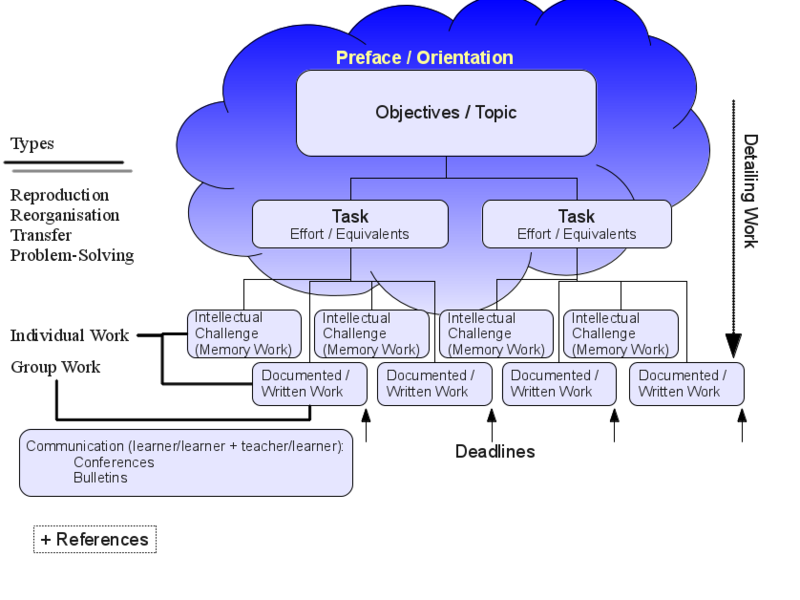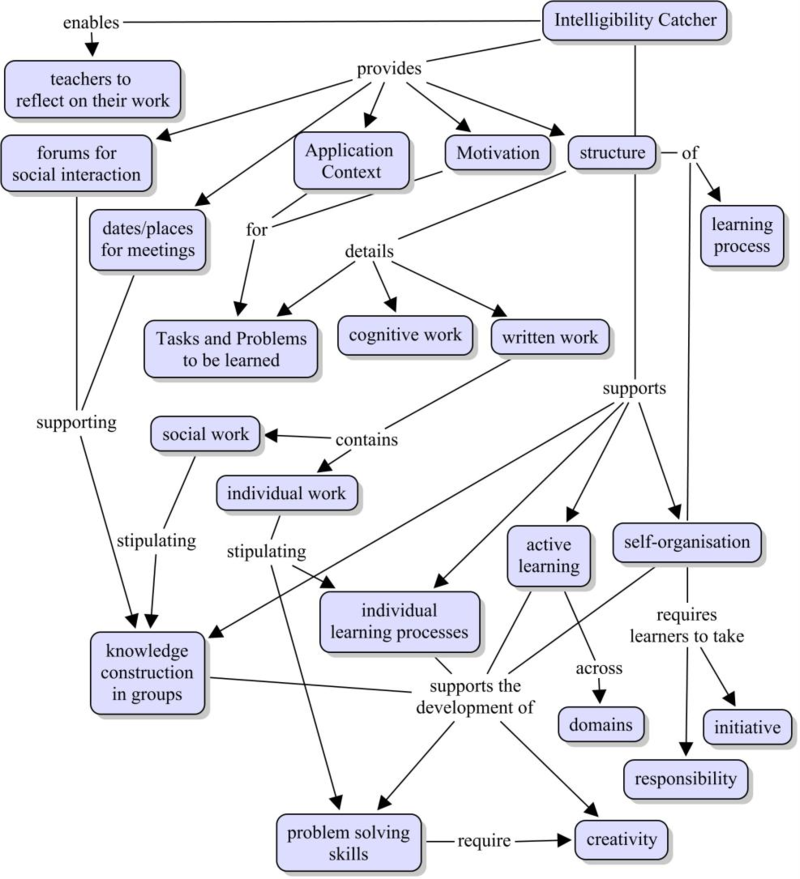Intelligibility catchers: Difference between revisions
mNo edit summary |
m (→Introduction) |
||
| (2 intermediate revisions by the same user not shown) | |||
| Line 2: | Line 2: | ||
== Introduction == | == Introduction == | ||
'''Intelligibility catchers''' are ''learning | '''Intelligibility catchers''' are ''[[learning contract]]s'' when designing individualized learning processes (cf. Stary, 2007 <ref name="stary2007">Stary, C. (2007). Intelligibility catchers for self-managed knowledge transfer. Proc. Seventh IEEE International Conference on Advanced Learning Technologies (ICALT 2007), IEEE Press, New York, 517–521.).</ref> They tell a leaner what to do and can be used to design e-learning modules. <ref name="stary2012">Stary, C., & Weichhart, G. (2012). An e-learning approach to informed problem solving. Knowledge Management & E-Learning: An International Journal (KM&EL), 4(2), 195-216. http://www.kmel-journal.org/ojs/index.php/online-publication/article/viewArticle/184</ref>. | ||
== The model == | == The model == | ||
| Line 27: | Line 27: | ||
: provides links and literature that could help to accomplish the tasks. | : provides links and literature that could help to accomplish the tasks. | ||
; The bulletins section | |||
: provides extra news/information. In e-learning, can be dynamically created using an online info board. | : provides extra news/information. In e-learning, can be dynamically created using an online info board. | ||
| Line 42: | Line 42: | ||
relationships between these aspects. In the upper part features provided by the IC are | relationships between these aspects. In the upper part features provided by the IC are | ||
described. In the lower part the embodied learning concepts are put in to mutual context, | described. In the lower part the embodied learning concepts are put in to mutual context, | ||
both for individual and collaborative learning processes.}} (p. 212 <ref name=" | both for individual and collaborative learning processes.}} (p. 212 <ref name="stary2012">Stary, C., & Weichhart, G. (2012). An e-learning approach to informed problem solving. Knowledge Management & E-Learning: An International Journal (KM&EL), 4(2), 195-216. http://www.kmel-journal.org/ojs/index.php/online-publication/article/viewArticle/184</ref>) | ||
[[File:stary-weichhart-intelligence-catchers-concept-map.png|800px|thumbnail|none|IC support for elearning (Stary, C., & Weichhart, G. (2012))]] | [[File:stary-weichhart-intelligence-catchers-concept-map.png|800px|thumbnail|none|IC support for elearning (Stary, C., & Weichhart, G. (2012))]] | ||
Latest revision as of 15:13, 13 April 2016
Introduction
Intelligibility catchers are learning contracts when designing individualized learning processes (cf. Stary, 2007 [1] They tell a leaner what to do and can be used to design e-learning modules. [2].
The model
An Intelligibility catcher (IC) has the following structure:
- The title
- should provide a thematic scope, and if possible convey emotional appeal. It should trigger expectations on how to engage and get involved when working on the addressed issue.
- The orientation / preface section
- addresses the stage of capacity building the IC should be used and what learners can expect when accomplishing the IC tasks. Its intention is to motivate and raise attention.
- The objectives section
- sets the scope in terms of the topics that are addressed in the learning tasks and the understanding that should result from exploring and processing learning content.
- The task section
- comprises a documented and an intellectual work part. The task section should contain different types of learning tasks which address different learning styles (i.e. tasks ranging from reproduction tasks to problem-solving tasks). It encourages active information search and exploration, communication, and individual problem-solving. On one hand, it refers to the concrete steps with respect to handle content and communication, on the other hand, it allows for model building in the sense of social learning theory. For self-organized learning, it is most essential to provide an indicative structure without anticipating the actual content. It would not only hinder model identification, modeling, and model embodiment, but also lead to standardized learning behavior patterns. In particular, the latter would prohibit model identification, and thus be not productive to social learning.
- The conference section
- sets deadlines and content for virtual and face-to-face meetings of the addressed learning community. It includes the time and date, the participants and the work to be prepared to be presented to the participants.
- The reference section
- provides links and literature that could help to accomplish the tasks.
- The bulletins section
- provides extra news/information. In e-learning, can be dynamically created using an online info board.
- Equivalents
- reveal the estimated individual effort for learners to meet the objectives.
Reproduced from Stary and Weichhart (2012:203-205 [2]) under a creative commons "BY" license with minor changes.
The different elements of an IC can be connected in some sort of instructional flow model as shown in the following figure
Finally, The following concept map “highlights different aspects of the researched approach and relationships between these aspects. In the upper part features provided by the IC are described. In the lower part the embodied learning concepts are put in to mutual context, both for individual and collaborative learning processes.” (p. 212 [2])
Bibliography
- ↑ Stary, C. (2007). Intelligibility catchers for self-managed knowledge transfer. Proc. Seventh IEEE International Conference on Advanced Learning Technologies (ICALT 2007), IEEE Press, New York, 517–521.).
- ↑ 2.0 2.1 2.2 Stary, C., & Weichhart, G. (2012). An e-learning approach to informed problem solving. Knowledge Management & E-Learning: An International Journal (KM&EL), 4(2), 195-216. http://www.kmel-journal.org/ojs/index.php/online-publication/article/viewArticle/184
- Stary, C. (2009). The design of e-learning contracts: Intelligibility catchers in praxi. Proc. IEEE/WIC/ACM International Joint Conference on Web Intelligence and Intelligent Agent Technology, IEEE Press, New York, Vol. 3, 203–206, http://www.computer.org/csdl/proceedings/icalt/2007/2916/00/29160517-abs.html (Access restricted)

